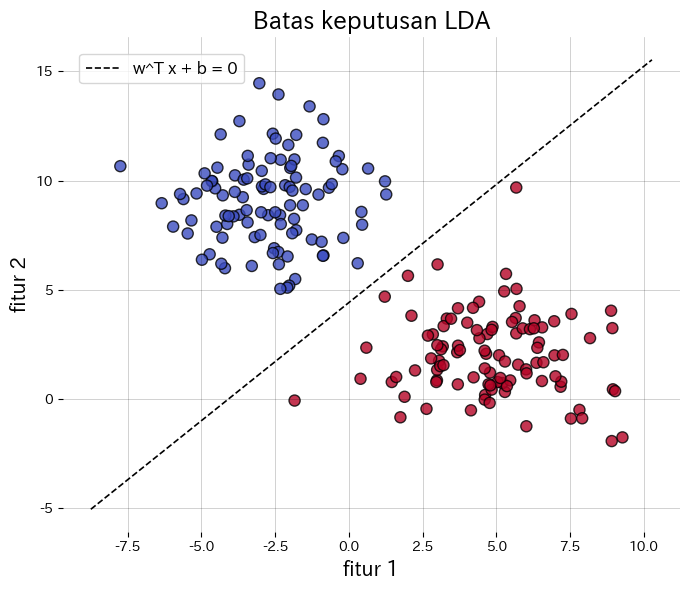- LDA mencari arah yang memaksimalkan rasio antara variansi antar kelas dan variansi intra kelas, sehingga berguna untuk klasifikasi sekaligus reduksi dimensi.
- Batas keputusan berbentuk \(\mathbf{w}^\top \mathbf{x} + b = 0\); di 2D berupa garis dan di 3D berupa bidang, mudah ditafsirkan secara geometris.
- Dengan asumsi tiap kelas berdistribusi Gaussian dan berbagi kovarians yang sama, LDA mendekati klasifikator Bayes optimal.
LinearDiscriminantAnalysisdi scikit-learn memudahkan visualisasi batas keputusan dan inspeksi fitur hasil proyeksi.
Intuisi #
LDA mencari arah proyeksi yang membuat sampel dalam kelas yang sama tetap rapat, namun mendorong sampel dari kelas berbeda saling menjauh. Setelah diproyeksikan, kelas menjadi lebih mudah dipisahkan, sehingga LDA dapat dipakai langsung untuk klasifikasi atau sebagai langkah reduksi dimensi sebelum model lain.
Formulasi matematis #
Untuk dua kelas, arah proyeksi \(\mathbf{w}\) memaksimalkan
$$ J(\mathbf{w}) = \frac{\mathbf{w}^\top \mathbf{S}_B \mathbf{w}}{\mathbf{w}^\top \mathbf{S}_W \mathbf{w}}, $$
di mana \(\mathbf{S}_B\) adalah matriks sebar antar kelas dan \(\mathbf{S}_W\) adalah matriks sebar intra kelas. Pada kasus multikelas diperoleh hingga \(K-1\) arah proyeksi yang berguna untuk reduksi dimensi.
Eksperimen dengan Python #
Contoh berikut menerapkan LDA pada data sintetis dua kelas, menggambar batas keputusan, dan menampilkan fitur hasil proyeksi 1D. Dengan transform, data hasil proyeksi dapat langsung diperoleh.
from __future__ import annotations
import japanize_matplotlib
import matplotlib.pyplot as plt
import numpy as np
from sklearn.datasets import make_blobs
from sklearn.discriminant_analysis import LinearDiscriminantAnalysis
from sklearn.metrics import accuracy_score
def run_lda_demo(
n_samples: int = 200,
random_state: int = 42,
title_boundary: str = "Batas keputusan LDA",
title_projection: str = "Proyeksi satu dimensi oleh LDA",
xlabel: str = "fitur 1",
ylabel: str = "fitur 2",
hist_xlabel: str = "fitur terproyeksi",
class0_label: str = "kelas 0",
class1_label: str = "kelas 1",
) -> dict[str, float]:
"""Train LDA on synthetic blobs and plot boundary plus projection."""
japanize_matplotlib.japanize()
X, y = make_blobs(
n_samples=n_samples,
centers=2,
n_features=2,
cluster_std=2.0,
random_state=random_state,
)
clf = LinearDiscriminantAnalysis(store_covariance=True)
clf.fit(X, y)
accuracy = float(accuracy_score(y, clf.predict(X)))
w = clf.coef_[0]
b = float(clf.intercept_[0])
xs = np.linspace(X[:, 0].min() - 1, X[:, 0].max() + 1, 300)
ys_boundary = -(w[0] / w[1]) * xs - b / w[1]
fig, ax = plt.subplots(figsize=(7, 6))
ax.set_title(title_boundary)
ax.scatter(X[:, 0], X[:, 1], c=y, cmap="coolwarm", edgecolor="k", alpha=0.8)
ax.plot(xs, ys_boundary, "k--", lw=1.2, label="w^T x + b = 0")
ax.set_xlabel(xlabel)
ax.set_ylabel(ylabel)
ax.legend(loc="best")
ax.grid(alpha=0.25)
fig.tight_layout()
plt.show()
X_proj = clf.transform(X)[:, 0]
fig, ax = plt.subplots(figsize=(8, 4))
ax.set_title(title_projection)
ax.hist(X_proj[y == 0], bins=20, alpha=0.7, label=class0_label)
ax.hist(X_proj[y == 1], bins=20, alpha=0.7, label=class1_label)
ax.set_xlabel(hist_xlabel)
ax.legend(loc="best")
ax.grid(alpha=0.25)
fig.tight_layout()
plt.show()
return {"accuracy": accuracy}
metrics = run_lda_demo(
title_boundary="Batas keputusan LDA",
title_projection="Proyeksi satu dimensi oleh LDA",
xlabel="fitur 1",
ylabel="fitur 2",
hist_xlabel="fitur terproyeksi",
class0_label="kelas 0",
class1_label="kelas 1",
)
print(f"Akurasi pelatihan: {metrics['accuracy']:.3f}")

Referensi #
- Fisher, R. A. (1936). The Use of Multiple Measurements in Taxonomic Problems. Annals of Eugenics, 7(2), 179窶・88.
- Hastie, T., Tibshirani, R., & Friedman, J. (2009). The Elements of Statistical Learning. Springer.